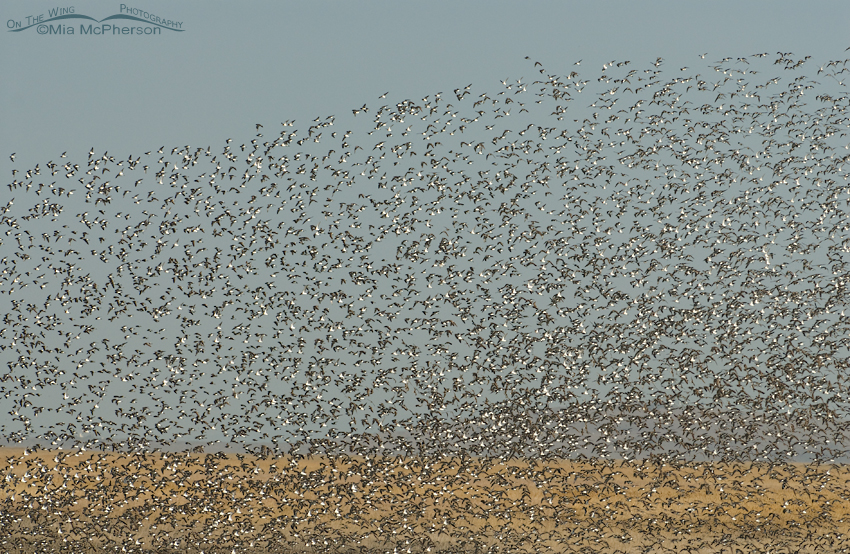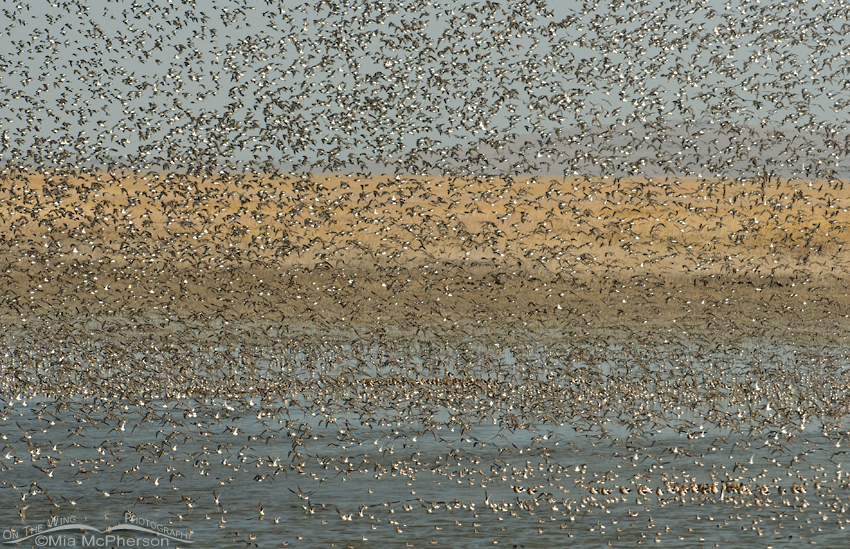 Wilson’s Phalaropes Murmuration – Nikon D200, f7.1, 1/1250, ISO 5600, +0.3 EV, Nikkor 200-400mm VR with 1.4x TC at 200mm, natural light
Wilson’s Phalaropes Murmuration – Nikon D200, f7.1, 1/1250, ISO 5600, +0.3 EV, Nikkor 200-400mm VR with 1.4x TC at 200mm, natural light
Before leaving for Red Rock Lakes National Wildlife Refuge in Montana last week I saw very few Wilson’s Phalaropes while on the causeway going to Antelope Island State Park in northern Utah. What a difference a week can make! You just never know what you will see unless you go out into the field.
Today there were hundreds of thousands of Wilson’s Phalaropes near the shoreline of the causeway, whirling around in the water and along the marshy areas not far from the park entrance. There are still some heavy, hauler trucks going back and forth on the causeway from the re-paving that has been done and those trucks cause the birds to lift off in a huge mass and their behavior is much like the murmurations of Red-winged Blackbirds and European Starlings. The mass of birds creates a wave-like movement and with these phalaropes their light bellies cause a flash of white when they turn in flight.
 Wilson’s Phalaropes mass lift off – Nikon D200, f7.1, 1/1250, ISO 500, +0.3 EV, Nikkor 200-400mm VR with 1.4x TC at 400mm, natural light
Wilson’s Phalaropes mass lift off – Nikon D200, f7.1, 1/1250, ISO 500, +0.3 EV, Nikkor 200-400mm VR with 1.4x TC at 400mm, natural light
I backed my 200-400mm with the 1.4x TC all the way to 200mm and the birds still completely filled this frame. There are a few American Avocets in the water but the birds in flight all appeared to be Wilson’s Phalaropes. Their diet in the hyper saline Great Salt Lake consists of brine flies and brine shrimp. The brine flies are currently present in the millions so I am certain these phalaropes are well fed. I also observed the phalaropes catching brine flies from the air. Something I had not witnessed before.
Life is good.
Mia
Click here to see more of my Wilson’s Phalarope photos plus facts and information about this species.


Impressive images. This may be a ritual for phalaropes and correspond with the start of summer. Phalaropes are unique in how they usually swim in circles when feeding, and, of course, the distinctions between the more colorful females and males, as well as the remarkable juvenile plumage and non-breeding winter plumage.
Mathew, I wish I could capture that spinning movement of phalaropes in a still image, it shows up best in video I believe. I think it is unique that the females are larger and more colorful than the males. They are a wonderful shorebird to photograph. Thanks!
I’ll take your titles more seriously in the future Not that anything could really have prepared me for THAT many Wilson’s Phalaropes… my jaw literally dropped. Wonderful to know that such scenes still exist
Not that anything could really have prepared me for THAT many Wilson’s Phalaropes… my jaw literally dropped. Wonderful to know that such scenes still exist
Thanks Nicolas, there were so many birds beyond my frames, I’d say a million or maybe more. Thanks for visiting my blog!
Mia, Just sent your link to my friend, that I’m going to Red Rock with, and I get a message back that you know him. It was Ron B, small world isn’t it.
William, it is a small world indeed! Ron and I gave tons of info to Ron B about Red Rock Lakes NWR and saw him out there last summer when he and his family visited the refuge. It is an amazing, beautiful and enchanting location.
Thanks for visiting and for your comments.
Looking through some of your great shots has me very excited about my trip to Red Rock Lakes next week. Thanks for sharing.
I counted 47, though I did round down ;). Amazing how they can find room to fly.
You made me giggle Stu!
WOW!!! Amazing sight and amazing images!!!
Thank you Beverly!
What an awesome sight, Mia! Filling the frame with the birds gives so much drama.
Julie, there sure is a lot of drama when there are so many birds in a flock lifting off and flying around. I can close my eyes even now and see it all! Thanks for your comment.
Absolutely stunning how many birds. wow.
Thank you Dan, it just takes my breath away to see so many all at once!
Amazing images Mia! To see these shorebirds in the thousands, traveling en masse, changing color from dark to light in a flash is joyous to watch. I would have loved to see this flock in person! I filmed a flock of Dunlins like this at Sacramento National Wildlife Refuge that you can see here. When they turn, the combination of their white bellies and wing flapping appears like fireworks sparklers in the sky.
Wow Larry, your video of the Dunlins is wonderful! I hope one day you can see this many Phalaropes in flight, that “flash” is so delightful, better than fireworks any day in my opinion! Thank you for commenting!
Wow, what a massive number of birds. I’ve never seen this species myself, but I would love to have seen this. Awesome!
Susan, I hope you get to see these birds and in these numbers. It is mind blowing! Thanks for your comment.
Wow. Staggering.
Yeah, staggering is a great description Steve. Mind-blowing is another!
Amazing sight Mia. I’d love to see some of your country out there some time.
Kathy, This area of the country has a wealth of wonderful birds, critters and great scenery! Thanks for commenting on these images.
That’s totally amazing! The only birds I’ve ever seen in such numbers are snow geese at Bosque del Apache. Must have been an amazing sight!
Linda, it is totally amazing to see so many birds at once. Thanks for your comment.
Mia, believe it or not, eBird has a post about how to count this many birds! You just pick a section, count the birds in that section and multiply it over the group! Wow! What a sight to see. I wish I could have been there! I really miss the Great Salt Lake and antelope island. It is such a special place!
Kathie, I’ll have to try that method of counting one day, maybe not on these images because there are so many birds!Thanks for the tip and your comment.
Wow that’s imposing! You captured the grandeur very well. I’ve never seen more than 2 dozen Phalaropes in one place, and I felt lucky at that. Nice work!
Laurence, there are tons out side of both frames. So many you just can’t believe it.